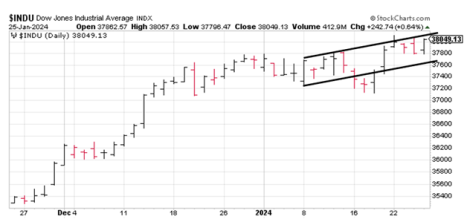As an almost 30-year veteran of the financial advisory business, I have a rather large collection of newsletters written by many analysts stretching back to the 1990s (back when newsletters were printed on paper and sent via snail mail!). I keep the ones I treasure the most in shoeboxes and take delight in occasionally going back and reading through them as a reminder of past market events and experiences.
In my latest trip down memory lane, I stumbled across a gem from the year 2001. It was a copy of the newsletter, Stock Cycles Forecast, written by Michael Jenkins. It’s especially pertinent to the current market as it’s entitled, “As January Goes, So Goes…”
We’ve all heard of the famous “January Effect,” which effectively states that January tends to outperform the other 11 months due to the tendency of late-year tax selling to depress equity prices entering the new year, thus paving the way for a strong performance in January.
[text_ad]
The January Effect is also commonly conflated with the January Barometer, which is the market’s supposed ability to (roughly) forecast the stock market’s year-ahead performance. The perception is that the dominant trend for stocks in January will impact how the broad market performs in the remainder of the year. But, according to Jenkins, this perception isn’t entirely accurate. Quoting him at length:
“Many people are familiar with the ‘January Effect’ which basically states that a high in January leads to a down year while a low leads to a bullish year. Few people, however, really understand what it’s about or where it came from. The great master of forecasting, W.D. Gann, said to look to January 2nd to 7th each year and whatever trend was in effect after that would last six months or more.”
I won’t go into the explanation Jenkins offered for the tendency of the January Effect to predict the market’s multi-month path, and I’m certainly cognizant that Gann isn’t everyone’s cup of tea. But it’s worth noting that Gann believed when stocks make a low in the early part of January, the low won’t be broken until at least the following July or August—and sometimes not for the rest of the year. Moreover, Gann’s version of the January Effect states that high prices made in early January are often the highs for the entire year, or aren’t exceeded until after July/August.
With this in mind, I thought it would be informative to look back and see just how accurate Gann’s version of the January Effect has been over the last couple of decades. For analytical purposes, the Dow Jones Industrial Average (DJIA) should ideally be used for this exercise instead of the S&P 500, due to the S&P’s higher concentration of tech stocks tending to skew the results.
The Accuracy of the January Effect
Here’s what I discovered: With the exception of 2018 (a down year for the Dow), 2016 (an up year) and 2014 (also an up year), the January Effect as described above did a reasonably consistent—if sometimes rough—job of predicting the Dow’s six-to-12-month performance over the last 25 years.
Especially informative was the tendency for a range-based market to foreshadow the coming six months or so. That’s a valid point considering the Dow has (as of January 25) traced out something of a trading range, albeit with an upward tilt.
With that in mind, what does the market’s performance in this year’s January to date tell us about what we can expect in the coming months? While the month isn’t quite over and the final results aren’t in, the Dow’s current performance suggests the coming year is likely to be more volatile than last year. It further suggests that while there should be some worthwhile buying opportunities in the months ahead, the potential for prolonged rallies (at least in the Industrials) is likely to be muted compared to the previous years.
If this indeed turns out to be the case, it would be very much in keeping with the so-called “Presidential Cycle,” which states that U.S. presidential election years typically deliver sub-par gains for investors. As a recent U.S. News & World Report article observed:
“Since 1952, the S&P 500 has averaged a 7% gain during U.S. presidential election years. While a 7% gain is far from disastrous, it is also well short of the 17% average S&P 500 gain in the year prior to an election year. It’s also below the roughly 10% average annual total return for the S&P 500 in a typical year.”
With that in mind—and assuming you’re inclined to accept the legitimacy of the January Effect—you should be prepared for the possibility that 2024 will be a choppier-than-normal year for equities and adjust your trading/investment strategy accordingly.
Here at Cabot, we can help you do that with Mike Cintolo’s Top Ten Trader. Expert stock picking is one of the main keys for navigating volatility, which is why Top Ten Trader is ideal for participants who want to focus on only the best-performing growth stocks for all market environments. Click here for details.
[author_ad]


